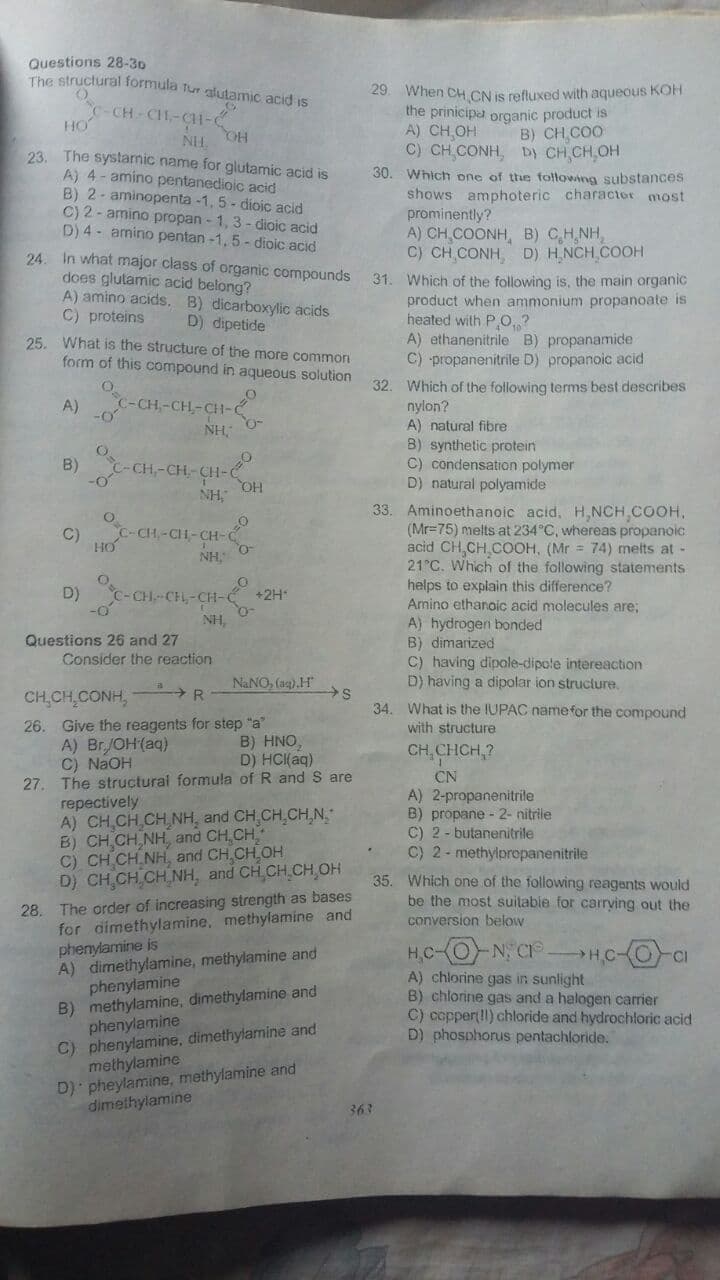Introduction to General, Organic and Biochemistry
11th Edition
ISBN:9781285869759
Author:Frederick A. Bettelheim, William H. Brown, Mary K. Campbell, Shawn O. Farrell, Omar Torres
Publisher:Frederick A. Bettelheim, William H. Brown, Mary K. Campbell, Shawn O. Farrell, Omar Torres
Chapter19: Carboxylic Anhydrides, Esters, And Amides
Section: Chapter Questions
Problem 19.13P
Related questions
Question
Answer Q32, 33, 34 showing detailly all explanations

Transcribed Image Text:Questions 28-30
The structural formula tur alutamic acid is
29. When CH CN is refluxed with aqueous KOFH
the prinicipa organic product is
A) CH OH
C) CH CONH, Dy CH CH OH
30. Which one of the following substances
shows amphoteric character most
prominently?
A) CH COONH, B) C,H,NH,
C) CH CONH D) H.NCH COOH
C-CH CH-CH1-
HO
B) CH COO
NH.
23. The systamic name for glutamic acid is
A) 4 - amino pentanedioic acid
B) 2- aminopenta -1, 5- dioic acid
C) 2 - amino propan - 1, 3 - dioic acid
D) 4 - amino pentan -1,5 - dioic acid
HO
24.
In what major class of organic compounds
D) dipetide
25. What is the structure of the more common
form of this compound in aqueous solution
does glutamic acid belong?
A) amino acids. B) dicarboxylic acids
C) proteins
31. Which of the following is, the main organic
product when ammonium propanoate is
heated with P O, ?
A) ethanenitrile B) propanamide
C) propanenitrile D) propanoic acid
-CH-CH-GİI-C
32. Which of the following terms best describes
nylon?
A) natural fibre
A)
NH,
B) synthetic protein
C) condensation polymer
D) natural polyamide
B)
CH-CH- CH-
NH,
HO
33. Aminoethanoic acid, H,NCH COOH,
(Mr=75) melts at 234°C, whereas propanoic
acid CH,CH COOH, (Mr = 74) melts at -
21 C. Which of the following statements
helps to explain this difference?
Amino ethanoic acid molecules are;
A) hydrogen bonded
B) dimarized
C) having dipole-dipole intereaction
D) having a dipolar ion struclure.
C-CH-CH-
HO
NH,
CH-CH
+2H
NH,
Questions 26 and 27
Consider the reaction
NaNO, (ag).H
CH CH,CONH,
R
34. What is the IUPAC namefor the compound
with structure
26. Give the reagents for step "a"
A) Br/OH(aq)
C) NaOH
27. The structural formula of R and S are
repectively
A) CH,CH CH NH, and CH,CH,CH,N,
B) CH CH NH, and CH,CH
C) CH CH NH, and CH CH.OH
D) CH,CH CH NH, and CH,CH.CH,OH
B) HNO,
D) HCI(aq)
CH,CHCH,?
CN
A) 2-propanenitrile
B) propane - 2- nitrile
C) 2 - butanenitrile
C) 2- methylpropanenitrile
35. Which one of the following reagents would
be the most suitable for carrving out the
conversion below
28. The order of increasing strength as bases
for aimethylamine, methylamine and
phenylamine is
A) dimethylamine, methylamine and
phenylamine
B) methylamine, dimethylamine and
phenylamine
C) phenylamine, dimethylamine and
methylamine
D) pheylamine, methylamine and
dimethylamine
H,C-(O N C
A) chlorine gas in sunlight
B) chlorine gas and a halogen carrier
C) copper!l) chloride and hydrochloric acid
D) phosphorus pentachloride.
HC-O CI
363
Expert Solution
This question has been solved!
Explore an expertly crafted, step-by-step solution for a thorough understanding of key concepts.
This is a popular solution!
Trending now
This is a popular solution!
Step by step
Solved in 5 steps

Knowledge Booster
Learn more about
Need a deep-dive on the concept behind this application? Look no further. Learn more about this topic, chemistry and related others by exploring similar questions and additional content below.Recommended textbooks for you

Introduction to General, Organic and Biochemistry
Chemistry
ISBN:
9781285869759
Author:
Frederick A. Bettelheim, William H. Brown, Mary K. Campbell, Shawn O. Farrell, Omar Torres
Publisher:
Cengage Learning

Introduction to General, Organic and Biochemistry
Chemistry
ISBN:
9781285869759
Author:
Frederick A. Bettelheim, William H. Brown, Mary K. Campbell, Shawn O. Farrell, Omar Torres
Publisher:
Cengage Learning